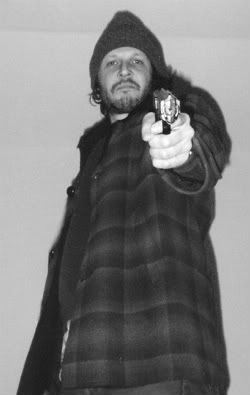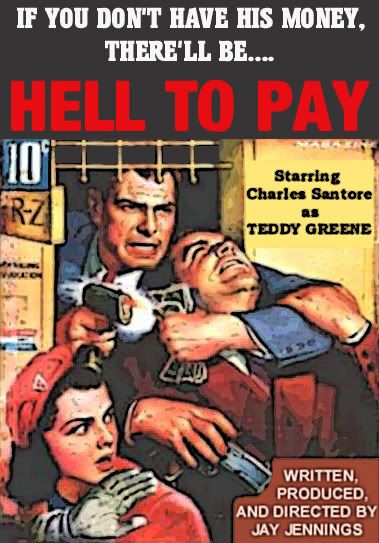 Many avid film fans dream of making their own movie, but don’t know the steps to take or where to start. Truly, it can be overwhelming to think about.
Many avid film fans dream of making their own movie, but don’t know the steps to take or where to start. Truly, it can be overwhelming to think about.
Thankfully, writer-director-producer (and editor, cinematographer, composer and actor) Jay Jennings, 45, who recently released his neo-noir film “Hell to Pay,” gave me the scoop on the whole process.
Jennings got the idea for “Hell to Pay,” the gritty Los Angeles-based story of violent debt collector Teddy Greene (Charles Santore), after thinking more about his love for film noir.
“I have been a lifelong fan of film noir and tend to write, produce and direct films containing neo-noirish traits, which began with my directorial debut, ‘Loanshark’ (1999). I’m also a big fan of the anti-hero, people who go up against all odds, who barely stand a chance in this world, giving it their all, no matter how futile it may seem,” Jennings explained. “A lot of these anti-heroes tend to live in a world full of violence, blackmail, double-crosses and unfair endings. I find these characters fascinating in that they go against the grain, trying to succeed where others have failed.”
Jennings decided to take a “cool, dark 1950s-like crime story” and make his character Teddy the centerpiece. “[Teddy] camouflages his bitterness by being a first class a-hole when it comes to his job as a debt collector. If people don’t have his money, he beats them up. It’s that simple and it works for him. He doesn’t know any other way to be but violent and merciless,” Jennings said.
He made sure to add some depth and conflict to Teddy’s character by having him have options of getting out of the dangerous debt collecting business.

The Writing Process
To get the writing juices flowing, Jennings had to get himself into film noir/gangster mode, something different than writing a comedy or a drama. “I concentrated on dark themes, seedy characters, gangsters and femme fatales and the traits that make them so interesting and mysterious,” he said.
Jennings has had the same writing process since he first started writing scripts. Once he gets a movie idea, he jots down the initial concept on a yellow writing pad. He includes information about the characters, plot points, locations and dialogue.
Next, it’s time to actually type the script. When he’s writing a script, Jennings starts typing it in Word at 9 a.m. and then breaks for lunch at noon. He continues to write until dinner at 6 p.m., and then finishes up his day’s work until 9 p.m. If he keeps with this pace, he usually finishes a script in two weeks.
“Hell to Pay” includes many interesting people who owe Teddy money. Each have their own little quirks and characteristics. Jennings said he came up with all these characters just from observing people in L.A.
“Having lived in Los Angeles and Hollywood for most of my life, I’ve been fortunate (or unfortunate) enough throughout the years to observe many people from all walks of life, and a big chunk of them are the ones who struggle to make it in this jungle called ‘life,’” Jennings mentioned. “From prominent businessmen to musicians, from junkies to housewives, from stand-up comics to college kids, they all seem to need that ‘one’ thing to survive…and that is money. So it is safe to say I based a bunch of the characters in ‘Hell to Pay’ on people I have either met, knew or bumped into at one point or another.”

The Casting Process
Jennings thoroughly enjoys auditioning novice and professional actors and actresses for his films. “To finalize the cast, I choose the best three actors/actresses for each role and have them read a section of their ‘sides’ and whoever can convey that character’s inner being in the most visual and verbal sense, most likely gets the part,” he noted.
Casting Santore as Teddy was a no-brainer. “Charles is one of the most talented and intense actors to ever grace a movie screen. His acting ability knows no boundaries,” said Jennings, who has worked with Santore before. “He was a very convincing Teddy Greene.”
Location, Location, Location
When looking for good places to shoot, Jennings prides himself on using real buildings, streets, alleys, apartments, etc. “This aspect of film-making truly adds to a film’s overall feel and look. Having grown up in L.A. is definitely an advantage because I know where all the cool places to shoot are,” he said. “When I write my screenplays, I kind of know where I’ll be shooting certain scenes and this helps greatly when it comes time to actually shoot the film.”
On the Set
 “Because I am the director/cameraman/DP of my films, you can rest assure I’ve got a dozen things running through my mind while I’m shooting a film,” Jennings stressed.
“Because I am the director/cameraman/DP of my films, you can rest assure I’ve got a dozen things running through my mind while I’m shooting a film,” Jennings stressed.
He has to make sure each scene is running smoothly and there’s nothing interfering with the scene, like background noises, people walking into the frame, etc. He also determines if more takes are needed, if the actors are hitting their spots and getting their lines right.
Composing the Score
Jennings is such a multi-tasker, he also composed the music for “Hell to Pay.” Being a musician since his teen years, he has composed hundreds of songs, most of them instrumentals.
“Having been a fan of movie soundtracks for many years, I completely understand the vital importance of adding music to any film,” he explained. “In ‘Hell to Pay,’ I felt it was necessary to give the overall sense of the film a nightmarish tone, that sometimes contains a paranoid, ‘the walls are closing in’ feeling, which involves playing single notes in a long drawn out manner, as well as low-key drones and augmented intervals.”
Post-Production
In the editing room, Jennings fits together the “pieces of a large jigshaw puzzle” he shot to make it into a fluid film.
Just like with the writing process, Jennings starts his editing at 9 a.m. and essentially works until midnight. “I look at editing as being similar to a sculptor,” Jennings noted. “You build the foundation of your project until it satisfies you and then you edit out all the externals you don’t think quite fit, until you finally reach a point where you are completely satisfied. This includes adding the opening and closing credits, musical score and sound effects.”
He acknowledges the editing process can be a long and grueling one. Overall, “Hell to Pay” was a three-month process for Jennings: a month of casting, a month of shooting and a month of editing and post-production.

To find out more about Jennings’ three incredible months, check out more information on the “Hell to Pay” Web site: www.helltopaymovie.blogspot.com
And check out the “Hell to Pay” trailer below:
Hell to Pay (trailer) from Jay Jennings on Vimeo.
. . .
Follow Amanda Koehler on Twitter at http://twitter.com/AEKoehler.
And don’t forget to “Like” It’s Just Movies on Facebook at
http://www.facebook.com/itsjustmovies.
Great interview, Amanda!